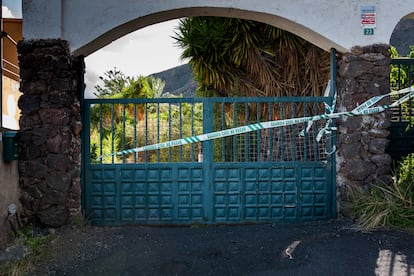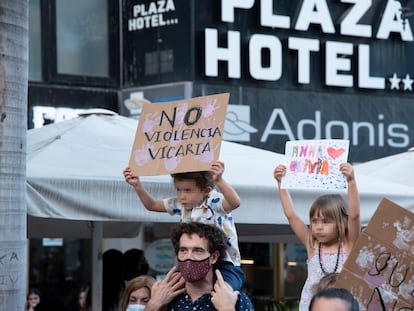Spanish child Olivia Gimeno was suffocated on the day she went missing, report shows
Autopsy on body found at bottom of the sea off Tenerife last year did not find traces of drugs. Her younger sister Anna, also allegedly kidnapped and killed by their father, has not been found


Olivia Gimeno Zimmermann, a six-year-old child whose body was found at the bottom of the sea off the Spanish island of Tenerife on June 10, 2021, died of a “violent death compatible with mechanical asphyxia by suffocation,” according to the definitive autopsy report, which showed no traces of any toxic substances.
The child had disappeared along with her one-year-old sister Anna, whose body was never found. It is believed that they were killed by their father, Tomás Gimeno, who was the last person to be seen with them. Before going missing himself he had warned the mother, Beatriz Zimmerman, that she would never see the children again. The couple had separated in 2020 after a long relationship.
According to the report, Olivia died on the day of her disappearance, April 27, at some point between 7.54pm and 9pm. This coincides with the timeline of events contained in court documents that were made public on June 12. According to these documents, Gimeno killed his daughters inside his house in Igueste de Candelaria, a municipality located in the east of Tenerife, one of Spain’s Canary Islands.
The search at first focused on land, but after several days investigators turned their attention to the waters off Tenerife. On the night of April 27, Tomás Gimeno had been seen coming and going from the marina in Santa Cruz de Tenerife. where he had a moored vessel.
An oceanographic research ship that had joined the search effort, the Ángeles Alvariño, located the anchor from Gimeno’s boat at a depth of 1,000 meters, three nautical miles off the city of Santa Cruz. Attached to the anchor were two sports bags; one contained Olivia’s body, and the other one was found open and empty, although investigators assume that it had contained Anna’s body. Tomás Gimeno has not been found either dead or alive.

According to court papers, which suggest Gimeno had planned what he would do, on the night before the crime he drove to a family property in Guaza – part of the tourist town of Arona, in the south of the island. There he carefully protected one of his vehicles, a black Alfa Romeo Giulia, with a car cover.
The next day, as agreed with his ex-partner, he went over to Beatriz Zimmermann’s house to collect the children and spend the evening with them. He was to pick them up at 5pm and return them to their mother at 9pm.
Gimeno first collected one-year-old Anna from Zimmermann’s house in Radazul, part of the municipality of El Rosario. He placed her in the infant car seat inside his Audi A3 and drove to an education center in El Rosario named Die Villa, where Olivia took lessons on Tuesdays and Thursdays. The center’s director was at the time in a relationship with Gimeno, and the latter gave her a pencil case wrapped in tape, telling her not to open it until 11pm and to call him at that time. Then he left with his daughters. According to the court documents, the woman ignored his instructions and at around 5.20pm she opened the pencil case to find €6,200 in cash inside and a goodbye letter.
Gimeno then drove to his parents’ house, leaving Anna in their care while Olivia took a tennis class that began at 6.30pm. During that time, Gimeno went to the marina to check that his boat, named Esquilón, was working correctly.
Gimeno and his daughters arrived at his residence in Igueste de Candelaria at 7.47pm. Three minutes later, Olivia sent a voice message to her mother to relay a message from her father: he wanted her to drive by his place at 9pm to pick up some paintings.
At 9.05pm, Gimeno left the rural property in his Audi A3 with his children’s bodies in the trunk. He drove towards Santa Cruz de Tenerife but stopped at his parents’ place at 9.13pm, where he left behind his dog Oto, two credit cards with their pin numbers and two sets of keys to his Alfa Romeo.

Meanwhile, Beatriz Zimmermann had arrived at Gimeno’s place some time after 9pm. She walked in, picked up the paintings and phoned her ex-partner, who lied and said that he and the children were having some dinner and that he would drive them back to her house in Radazul.
At 9.27pm Gimeno was back at the marina in Santa Cruz. He made three trips from the car to the boat, carrying several objects that included the sports bags. At 9.40pm he set sail. Beatriz Zimmermann phoned him again at 9.51pm, nervous that the children weren’t back yet. This time, his ex informed her that he was “off the island with the girls.” In another conversation at 9.59pm, he told her that she would never see him or the children ever again.
Zimmermann phoned him again at 10.30pm and 10.40pm, this time from a Civil Guard station where she’d gone to report the case. In one of these calls, Gimeno even talked with a Civil Guard officer. While he talked, he was getting closer to completing his tragic plan. At approximately 10.30pm, “in an area that he was familiar with” according to the court papers, he dumped the bags containing his children’s bodies, attaching them to the anchor to ensure they would stay at the bottom.
Fourteen minutes later, his cellphone ran out of battery and he decided to return to port. At 11.15pm, he was intercepted by a Civil Guard patrol boat, and was told to go home and that he would be fined for violating the local coronavirus curfew in place at the time. Gimeno told them he would sleep in his boat, and when they left he asked the marina watchman to lend him a cellphone charger. Since it was not compatible with his phone, Gimeno then went to a gas station where he purchased a new charger, a pack of cigarettes and a bottle of water. At 11.58pm he went back to the marina, charged his phone at the watchman’s office for 15 minutes, then went back to the boat and sailed away at 27 minutes past midnight, never to be seen again.
Tu suscripción se está usando en otro dispositivo
¿Quieres añadir otro usuario a tu suscripción?
Si continúas leyendo en este dispositivo, no se podrá leer en el otro.
FlechaTu suscripción se está usando en otro dispositivo y solo puedes acceder a EL PAÍS desde un dispositivo a la vez.
Si quieres compartir tu cuenta, cambia tu suscripción a la modalidad Premium, así podrás añadir otro usuario. Cada uno accederá con su propia cuenta de email, lo que os permitirá personalizar vuestra experiencia en EL PAÍS.
¿Tienes una suscripción de empresa? Accede aquí para contratar más cuentas.
En el caso de no saber quién está usando tu cuenta, te recomendamos cambiar tu contraseña aquí.
Si decides continuar compartiendo tu cuenta, este mensaje se mostrará en tu dispositivo y en el de la otra persona que está usando tu cuenta de forma indefinida, afectando a tu experiencia de lectura. Puedes consultar aquí los términos y condiciones de la suscripción digital.
More information
Últimas noticias
Most viewed
- Reinhard Genzel, Nobel laureate in physics: ‘One-minute videos will never give you the truth’
- Oona Chaplin: ‘I told James Cameron that I was living in a treehouse and starting a permaculture project with a friend’
- Pablo Escobar’s hippos: A serious environmental problem, 40 years on
- Why we lost the habit of sleeping in two segments and how that changed our sense of time
- Chevy Chase, the beloved comedian who was a monster off camera: ‘Not everyone hated him, just the people who’ve worked with him’










































